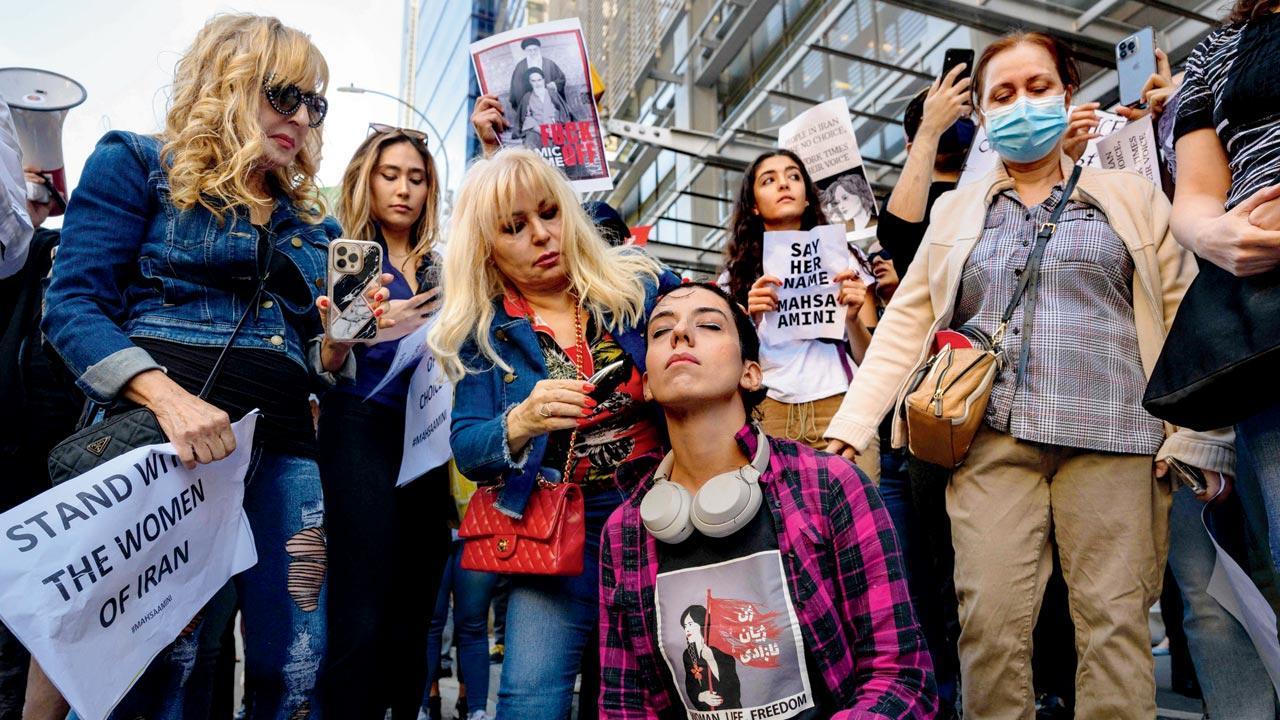What has Internet and Iran taught me about its nationwide, lethal/brave protests against the hijab?

Activist Forouzan Farahani gets her head shaved in protest against the death of Mahsa Amini in Tehran, Iran, for not wearing a hijab. Pic/AFP
 Like there are two Indias, there really are two Irans—although it’s fair to suggest there are two ‘every place’, depending on how rich/powerful you are, and what you can get away with anyway.
Like there are two Indias, there really are two Irans—although it’s fair to suggest there are two ‘every place’, depending on how rich/powerful you are, and what you can get away with anyway.
ADVERTISEMENT
But no, the ‘two Irans’ seem a special case. Given the first thing you notice as you enter its capital Tehran (as I did over a decade ago)—is witness how dramatically distinct a society can be from the state that governs it! It feels unique.
By the state, I mean Islamic clerics, who rule with the iron-hand of religion, relegating their subjects behind an iron curtain. Being a man, the other men you meet in Tehran—majority of them young, walking around ruins that used to be nightclubs once—seem entirely pluralistic/secular, if not atheists, interested in fun, females, and football.
They’re equally obsessed with the Internet, deeply curious to establish connect with the outside world. As I could tell with my host, Ali, who’d taken days off from work, to give me company, and was in tears, when we finally bid goodbye at the metro. These Persian Muslim men, I noticed, make it a point to identify themselves as separate from Arabs.
What about the incredibly stylish women, besotted by shoes, and designer-label headscarves, in public—to make peace with black-uniformed ‘moral police’ on streets? Guys tell you they wear ‘the pants at home’—the patriarchal term for who’s the boss, when state-rules can’t apply.
Also, more women than men attend college, and from advertisements on streets, they appear totally into martial arts as well—in every sense, merely reflecting the generations before them.
How did the present state come to be? All arrows point to the people’s self-directed Iranian Revolution of 1979, which was a nationwide movement to dislodge the US-backed Shah of Iran. While the economy was tanking, their ruler was seen to be reveling in the riches. By all accounts, this mass uprising—led by Leftists, liberals, and what sounds like an oxymoron, Islamic-Leftists—had little to do with religion.
Only the person they replaced the Shah with, as a consensus candidate, was the Shia cleric Ayatollah Khomeini, exiled in Paris, to eventually establish the Islamic republic. He publicly offered representative democracy, returning power to the people, and for himself, a life of quiet retirement. Which isn’t how it quite panned out.
And that may well be true, regardless, for when you mix religion with politics—all that remains then is religion! A society/economy is further doomed, I guess, if religion trumps rights of humans itself—unless you’ve found oil under your feet, no?
For all of the dynast Shah’s faults, he offered Iranians, personal freedoms—hardly ever interfering with what they wore, read, sang, wrote, serenaded, etc.
The Islamic dictatorship, over a monarchy, reversed that. Years of music archives were destroyed. Step by step, censorship in all aspects of life put in place—starting with the hijab (and dress-code) for women, introduced only for the workplace first, in 1981.
As the Persian master-director Majid Majidi told me, the Iranian Revolution also miraculously brought forth the ‘Iranian New Wave’ in cinema—with filmmakers figuring alternative ways to express their humanism, instead: “Until people began to watch films from Iran, they felt it was a harsh place. Their views changed drastically. Fanatics have nothing to do with Islam.”
This artistic response, on the face of it was apolitical, in the sense of leaving the state alone. And that’s because Majidi, a devout Muslim himself, still sees Iran’s cultural-religious nationalism as a passing phase: “Governments come and go. People remain. Films, unlike newspapers, don’t get stale in a week. Cinema is made for generations.”
Only that all religious fundamentalisms, while elementally competing against each other, appear to unanimously agree on one thing: the lower status of the woman still. Where was the brave pushback against such unhinged politico-religious power ever going to come from?
It was just so many women, I observed, at the protest headquarters in Cairo, Egypt, much after the Arab Spring, in 2012. Likewise the faces of the leaderless, social-media led, anti-CAA protests in New Delhi (2019-20) were women too.
Unsurprisingly, ones in Iran, to also boldly say they’ve had enough of the moral police—responsible for the death of a suburban woman, Mahsa Amini, because she wasn’t wearing her hijab right, at the Tehran metro.
Unaccounted hundreds have died in the anti-hijab/pro-choice protests since. Thousands arrested. Internet restricted. WhatsApp, Instagram banned.
But I’ve been surrounded by Iranian women still, casually swiping, chatting with them, over days, since. How? On ‘travel mode in Tehran’, on a dating app! Given no defiance can be greater for a country, where a woman can’t even be physically alone in the same room (not even in office), with a man, who’s not her relative.
You travel across this digital world, under the radar, of sartorially liberated Persian women, in chilling/party/bikini pix—with bios that read, “My life, my rules”—you know something’s gotta ultimately snap in the unsustainable, semi-schizophrenic chasm, between their private lives, and expectedly public selves.
“The situation is bad. My country just wants to kill people,” Mitra (name changed), 37, tells me. “What’s the future?” I ask Mitra. She drops a prayer emoji. I do the same.
Mayank Shekhar attempts to make sense of mass culture. He tweets @mayankw14
Send your feedback to mailbag@mid-day.com
The views expressed in this column are the individual’s and don’t represent those of the paper
 Subscribe today by clicking the link and stay updated with the latest news!" Click here!
Subscribe today by clicking the link and stay updated with the latest news!" Click here!







